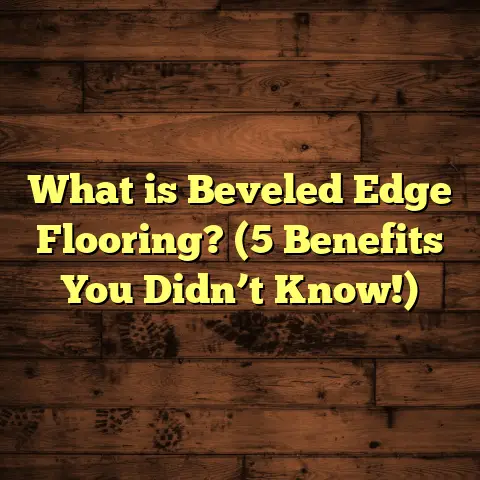What is Involved in Replacing Carpet with Hardwood Floors? (7 Steps to a Stunning Transformation)
What is Involved in Replacing Carpet with Hardwood Floors? (7 Steps to a Stunning Transformation)
Have you ever walked into a room and felt like the carpet just doesn’t belong anymore? Maybe it’s stained, worn out, or no longer fits your style. I’ve seen that feeling many times—both in my own home and in the homes of clients. That moment when you decide carpet has to go and hardwood floors must come in instead. But what exactly does that involve?
Switching from carpet to hardwood flooring is one of the most impactful home improvements you can make. It completely changes the look, feel, and even the value of your home. But it’s not just about ripping up the old carpet and putting down new wood boards. There are several important steps to follow, from preparation to finishing touches. I want to share everything I’ve learned through years of experience with flooring projects—what works, what to watch out for, and how to get results you’ll love.
Let’s walk through the seven key steps that make this transformation possible.
What is Replacing Carpet with Hardwood Flooring?
Replacing carpet with hardwood flooring means removing your existing carpet and installing hardwood planks or boards as the new floor surface. Hardwood floors are made from solid wood or engineered wood and offer durability, beauty, and a classic look that many homeowners prefer.
Why Choose Hardwood Over Carpet?
There are plenty of reasons why people choose hardwood floors over carpet:
- Longevity: Hardwood floors can last decades with proper care. Carpet typically lasts 5-15 years before needing replacement.
- Maintenance: Hardwood floors are easier to clean and don’t trap dust, pet dander, or allergens like carpet does.
- Appearance: Hardwood adds warmth, character, and a timeless aesthetic that can fit any decor.
- Value: Homes with hardwood floors tend to sell faster and at higher prices.
- Health: For allergy sufferers, hardwood floors improve indoor air quality by reducing dust accumulation.
Types of Hardwood Flooring
You’ll mainly encounter two types of hardwood flooring:
- Solid Hardwood: Made from a single piece of wood, solid hardwood is thick and can be sanded and refinished multiple times.
- Engineered Hardwood: Made from several layers of wood veneer glued together, engineered hardwood is more stable in humid environments and easier to install in some cases.
Choosing between these depends on your budget, climate, room location, and personal preference. I’ve worked with both types extensively and can say each has its place.
Step 1: Preparing for Carpet Removal
Before any new flooring can go down, you have to remove the old stuff. Carpet removal might sound straightforward—just rip it up—but there’s more beneath the surface.
What You’ll Find Underneath
Under carpet, there’s usually:
- Carpet padding (the foam or fiber layer)
- Tack strips nailed into the subfloor around the perimeter
- Staples or nails securing the padding
- Possibly glue spots or adhesive residue
I once removed carpet from a client’s basement and found multiple layers of padding and old glue that took hours longer than expected to clean up. Patience here pays off.
Tools and Tips for Removal
You’ll want:
- Utility knife (to cut carpet into manageable strips)
- Pliers or crowbar (to pull up tack strips)
- Gloves (carpet tack strips have sharp nails)
- Knee pads (because you’ll be on the floor a lot)
Work slowly to avoid damaging the subfloor beneath. Remove all staples and nails as well.
Pro Tip: Rent a heavy-duty dumpster or arrange for trash removal in advance. Carpet and padding take up a lot of space.
Step 2: Inspecting and Repairing the Subfloor
Once the carpet is out, it’s time for a close look at your subfloor—the surface you’ll lay your hardwood on.
Why Subfloor Condition Matters
Your subfloor must be:
- Flat
- Clean
- Dry
- Structurally sound
If it’s uneven or damaged, your hardwood floors will suffer problems like squeaking, cracking, or gaps over time.
Common Subfloor Materials
Most homes have plywood or OSB (oriented strand board) subfloors over joists. Basements or slabs use concrete.
In one house I worked on, the subfloor was plywood with some water damage near a window. We replaced those sections to avoid future warping.
How to Check for Levelness
Use a long level or straightedge across different areas. Any dips greater than 3/16 inch over 10 feet should be leveled out.
High spots can be sanded down; low spots filled with leveling compound.
Moisture Testing
Especially if you have a concrete slab or basement area, check moisture levels using a moisture meter.
Too much moisture can ruin hardwood floors quickly.
Step 3: Selecting Your Hardwood Flooring
Choosing the right hardwood is where style meets function.
Species Choices
Some popular options include:
- Oak (red or white): Durable and classic
- Maple: Fine grain and smooth finish
- Hickory: Very hard with lots of character
- Walnut: Darker, rich tones
- Cherry: Warm reddish hues
Each species varies in hardness measured by the Janka scale. For example:
| Wood Type | Janka Hardness (lbf) |
|---|---|
| Red Oak | 1290 |
| Hard Maple | 1450 |
| Hickory | 1820 |
| Walnut | 1010 |
| Cherry | 950 |
Hardness affects how resistant your floors will be to dents and scratches.
Solid vs Engineered Hardwood
I prefer solid hardwood for main living areas because it sands well and lasts long. Engineered hardwood works great in basements or kitchens where moisture might be an issue.
Finish Options
Hardwood comes prefinished or unfinished.
- Prefinished: Less mess, factory-applied finish, ready to use immediately.
- Unfinished: Installed raw then sanded and finished on-site. Allows custom stain colors but adds time and dust.
Step 4: Acclimating Your Hardwood Flooring
This step often surprises homeowners but is critical for success.
What is Acclimation?
Wood reacts to humidity by expanding or contracting. Acclimating means letting your flooring adjust to your home’s environment before installation.
How Long to Acclimate?
Most manufacturers recommend 3–7 days inside the rooms where the wood will be installed.
I always open boxes carefully and spread planks out flat on the floor during this time.
Benefits of Acclimation
Skipping this step can cause:
- Gaps between boards after installation
- Buckling or warping
- Cracking finishes
Step 5: Installing Hardwood Floors
Installation methods vary depending on wood type, subfloor, and personal preference.
Common Installation Methods
- Nail-down: Common for solid hardwood on plywood subfloors.
- Staple-down: Similar to nail-down but uses staples.
- Glue-down: Used for engineered hardwood over concrete.
- Floating: Boards click together without nails or glue; popular for DIY projects.
My Experience Installing Floors
For my own home, I nailed down solid oak in the living room. It took about five days working with a crew of two—removing baseboards first, laying down moisture barrier paper, then carefully nailing each plank.
In another project with engineered hardwood over concrete, we glued the planks down carefully after spreading adhesive evenly.
Important Tips During Installation
Leave a 1/2-inch expansion gap around all walls for wood movement.
Use spacers during installation to maintain consistent gaps.
Check every few rows for levelness and alignment.
Step 6: Sanding and Finishing (If Unfinished)
If you choose unfinished hardwood, this step follows installation.
Sanding Process
Sanding smooths out any unevenness and prepares wood for stain or finish. It’s messy work involving several passes with increasingly fine grit sandpaper.
I rented a drum sander for my dining room project and hired professionals for best results.
Applying Finish
Common finishes include:
- Polyurethane (oil-based or water-based)
- Wax
- Aluminum oxide coatings (factory applied)
Three coats are typical for durability. Allow thorough drying between coats.
Prefinished Wood Saves Time
If you go with prefinished hardwood, this step is skipped entirely. No sanding or finishing mess required.
Step 7: Adding Baseboards and Transition Strips
The final touches make all the difference in appearance and functionality.
Baseboards
Replace or reinstall baseboards after flooring is done to cover expansion gaps. I like using quarter-round molding along baseboards for extra coverage.
Transition Strips
These are essential where hardwood meets tile, carpet, or other flooring types in adjoining rooms. They create smooth transitions and hide edges.
Caring for Your Hardwood Floors Long-Term
After investing time and money into hardwood floors, proper care keeps them looking stunning for years.
Cleaning Tips
Avoid wet mops or harsh chemicals that damage finishes.
Use microfiber dust mops or vacuum attachments designed for hardwood floors regularly to remove dust and grit that scratch surfaces.
For spills, wipe immediately with a dry cloth.
Preventative Measures
Place rugs in high traffic areas like entryways and hallways.
Use felt pads under furniture legs to prevent dents.
Maintain indoor humidity between 35%–55% to minimize wood movement.
Personal Stories that Highlight Key Points
When I replaced carpet with hardwood in my own home almost ten years ago, I was amazed at how much warmer the rooms felt. The living room went from feeling dated and dull to fresh and inviting overnight. But I also learned some hard lessons:
- The first contractor I hired didn’t properly remove all carpet glue residue which made nailing difficult. We had to redo some sections.
- Skipping acclimation led to small gaps that appeared after a few months; patience really matters.
- Choosing solid oak was perfect for durability but required more precise leveling work on my old subfloor.
For another client in a coastal area with high humidity, we chose engineered hardwood glued down over concrete slab. That project taught me how critical moisture barriers are in preventing future problems like cupping or warping.
Data Points Backing Hardwood Flooring Benefits
- According to the National Wood Flooring Association (NWFA), homes with hardwood floors can increase resale value by up to 2–3%.
- A study by Zillow found homes with hardwood floors sell 17% faster than those with carpeted floors.
- Hardwood floors reduce indoor allergens by trapping less dust compared to carpets — a big plus for allergy sufferers according to the American Lung Association.
Typical Costs Involved in Replacing Carpet with Hardwood Flooring
Knowing what you’re likely to spend helps avoid surprises later on:
| Cost Factor | Low End | High End |
|---|---|---|
| Carpet Removal | $1 – $2 per sq.ft | $3 per sq.ft |
| Subfloor Repair/Leveling | $1 – $3 per sq.ft | $5 per sq.ft |
| Hardwood Material | $3 – $10 per sq.ft | $12 – $20 per sq.ft |
| Installation Labor | $4 – $8 per sq.ft | $10 per sq.ft |
| Finishing (if unfinished) | $1 – $3 per sq.ft | $4 per sq.ft |
| Baseboards & Transitions | $1 – $2 per linear ft | $3 – $5 per linear ft |
For an average 500 sq.ft living room:
- Budget roughly $4,000–$8,000 total depending on choices.
Many homeowners find this investment worthwhile due to long-term durability and resale benefits.
Common Questions Homeowners Ask Me About This Process
Q: Can I install hardwood floors myself?
A: If you have some DIY skills, floating engineered hardwood is doable. Nail-down solid wood usually requires professional equipment and experience.
Q: How long does the whole process take?
A: From carpet removal through finishing touches usually takes 1–2 weeks depending on room size and conditions.
Q: Will hardwood floors scratch easily?
A: Softer woods scratch more; harder species resist damage better. Using rugs and pads helps protect any type of wood floor.
Q: Is it noisy?
A: Proper subfloor prep minimizes squeaks. Floating floors can sometimes sound hollow unless underlayment is used correctly.
Final Thoughts on Making Your Flooring Transformation Successful
Replacing carpet with hardwood flooring is an investment that changes not just your home’s style but also its atmosphere and value. The process involves careful preparation, choosing the right materials, skilled installation, and ongoing care. From my personal experience and work with clients over many years, taking your time through each step pays off with stunning results that last a lifetime.
If you’re ready to get rid of your old carpet and bring beautiful hardwood into your home, start by evaluating your subfloor condition today—and maybe take a peek at some wood samples while you’re at it!
Got questions about any part of this process? Feel free to ask—I’m happy to help you plan your flooring project right!





